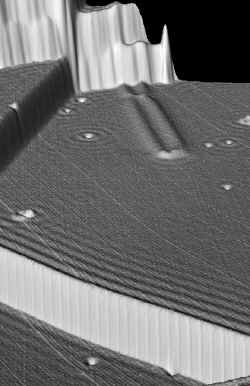Reading the Ripples of Electrons

The scanning tunneling microscope (STM) has given researchers an unparalleled close-up view of the individual atoms on surfaces, not to mention some popular “gee-whiz” pictures. Those images often show static waves on certain metal surfaces, a sign of the wavelike nature of the surface electrons. Now a Swiss team has used those wave features to measure the lifetime of surface electrons–a property that directly influences many processes but is difficult to measure by other means. Their results, published in the 31 May PRL, suggest a strong connection between the surface electrons and those in the crystal’s interior.
Some of the prettiest STM pictures of copper surfaces show what look like ripples of water spreading out in circles from each defect and moving in straight lines from each step edge. These waves are caused by the interference of “electron waves” moving toward and away from each defect or step. But the ripples die away within a short distance of the surface features because electrons eventually scatter from one quantum state into another, destroying the pattern. So the lifetime during which an electron remains in a specific quantum state before scattering is directly reflected in the distance over which the ripples persist away from a step edge.
The surface electron lifetime is an important property that directly affects many processes on surfaces, such as those related to deposition of atoms on metals–an area of great interest to industry. Lukas Bürgi and his colleagues at the Swiss Federal Institute of Technology in Lausanne decided to use STM imaging to systematically determine electron lifetimes based on the ripple patterns near steps on copper and silver surfaces. The traditional method for measuring surface electron lifetimes involves focusing a light beam onto several square microns of a surface and measuring the electrons emitted, but interpreting the data is complicated by unknown imperfections on the surface. With the STM “you can choose the place which is perfect on the surface,” Bürgi explains, by looking at the pristine region near a step, for example, where the quantum theory is relatively simple.
The team measured the persistence lengths of the wave patterns over a range of different electron energies by varying the so-called bias voltage between the sample and the STM probe. The lifetime values and energy dependence they found are similar to what is expected for electrons in the interior–or “bulk”–rather than the expectation for electrons living independently on a surface. Because the lifetime is determined mainly by electron-electron interactions, Bürgi and his colleagues conclude that the surface electrons interact strongly with bulk electrons, an idea that has been suggested by other types of experiments.
Phaedon Avouris of the IBM Watson Research Center in Yorktown Heights, NY, says that he and others were aware of the connection between the STM ripples and electron lifetimes when such images were first recorded in the early 1990s. But “the advantage of this work is that it is quantitative,” he says, because the researchers systematically analyzed the ripples. Wolf-Dieter Schneider of the University of Lausanne has recently used another STM technique that can measure lifetimes at only a single value of electron energy. He says the two STM methods each have their advantages, so “everyone should really go and use both.”


